Artists' Suffrage League
The Artists' Suffrage League was founded in January 1907 by professional women artists to help with the preparations for the first large-scale public demonstration by the National Union of Suffrage Societies. Its object was "to further the cause of Women's Enfranchisement by the work and professional help of artists... by bringing in an attractive manner before the public eye the long-continued demand for the vote." (1)
The first chairperson of the Artists' Suffrage League was Mary Lowndes, an important stained-glass and poster artist. She designed many of the banners used by the NUWSS including those for the demonstration of 21 June 1908, and for the Women's Pageant of Trades and Professions held the following year at the Albert Hall as part of the International Woman Suffrage Alliance Congress. (2)
Lowndes pointed out in her treatise On Banners and Banner-Making (1909): "A banner is not a placard... a banner is a thing to float in the wind, to flicker in the breeze, to flirt its colours for your pleasure, to half show and half conceal a device you long to unravel: you do not want to read it, you want to worship it." (3)

Philippa Strachey explained in a letter to Millicent Garrett Fawcett about the importance of Lowndes to the NUWSS. "On the Committee she was most helpful about everything and was delightful to work with because she was entirely free from any sort of nonsense; she only cared about the success of the procession as a whole and was perfectly willing to subordinate her decorations and give up all her cherished ideas when difficulties cropped up. She really did an immense amount of work for us and I shudder to think of what has happened to her own trade meantime." (4)
Emily Ford
Emily Ford was appointed as vice-chairman of the Artists' Suffrage League. (5) A long-term supporter of women's suffrage Ford joined the Manchester Society for Women's Suffrage in 1886. Three years later she signed the Women Householder's Declaration in favour of women's suffrage, and in 1897 was one of seventy-six painters listed as supporting the National Union of Women's Suffrage Societies. During this period she painted the portrait of Josephine Butler, that is now in the Leeds Art Gallery. (6) Ford was also the vice-president of the Leeds Suffrage Society and designed its membership card. (7)
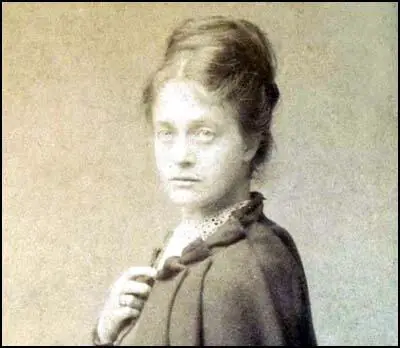
Emily Ford's painting, Towards the New Dawn was described as a feminist painting and was given by Millicent Fawcett to Newnham College in 1890. The painting, an allegory imbued with renewed and potentially radical significance thanks to its new title and location, was hung in Newnham’s Common Room, where it would have been visible to staff and students. (8)
Emily and her sister Isabella Ford, influenced by their friend, Edward Carpenter, both became socialists and helped form a Leeds branch of the Independent Labour Party (ILP). Other local members included Mary Gawthorpe and Ethel Annakin, who were also active in the struggle for women's suffrage. (9) As a member of the Women's Trade Union League Ford supported strikes of women weavers and the tailoresses in 1888 and 1889 with practical assistance and contributions towards the strike fund. (10)
According to Dora Meeson Coates, Emily Ford's cottage and studio at 44 Glebe Place, provided a meeting place for "artists, suffragists, people who did things. She had been a great beauty and, though no longer young... was still full of charm, with a wondrous energy for life and work." (11)
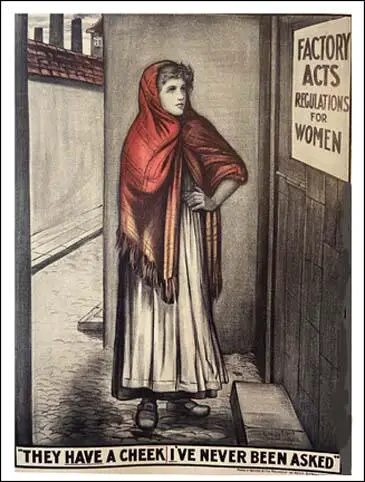
In 1908 Emily Ford produced one of the Artists' Suffrage League's most popular posters, "Factory Acts. They Have a Cheek. I've Never Been Asked." It was a protest against the various Factory Acts where the regulations governing women's work were made by men without consulting women workers. The art-work was also produced as a post-card that was sold at meetings. (12) It was also used by The Common Cause to illustrate an article on how the vote would affect the position of working women. (13)
1909 Artists' League Competition
The Artists' League organised competitions on behalf of the National Union of Suffrage Societies. As Lisa Tickner has pointed out: "There is some suggestion that competitors needed help in formulating their ideas, and designers were encouraged to send in thumbnail sketches in advance. Even trained artists could be ignorant of the particular requirements of a picture poster, and good designs that would make an impact and reproduce efficiently were difficult to come by." (14)
In February 1909 a prize of £5, together with several smaller prizes of one pound each, was offered by the Artists' League for "the best design for a poster, suitable for use in elections." (15) It is estimated that over thirty artists entered the competition. Philippa Strachey, the secretary of the London Society for Women's Suffrage suggested to her cousin, the artist Duncan Grant, submit an entry. Grant submitted Handicapped! and shared the first prize of £5. (16)
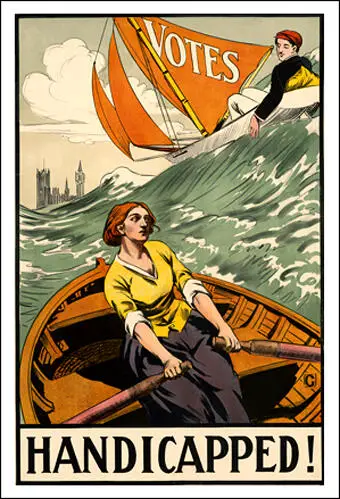
The Common Cause newspaper described it as depicting "a stalwart Grace Darling type struggling in the trough of a heavy sea with only a pair of sculls, while a nonchalant young man in flannels glides gaily by, with a wind inflating his sail - the vote - treating with good temper a subject which often causes bitterness." (17) It has been argued that it was "one of the most successful and striking of suffrage designs." (18)
Caroline Watts
Caroline Watts became a member of the NUWSS and the Artists' Suffrage League (ASL). In 1908 Watts produced The Bugler Girl to advertise the important June 1908 NUWSS procession. Elizabeth Crawford has pointed out: "The central figure in this, the 'Bugler Girl', is closely associated with the heroic images Caroline was creating for the books commissioned by David Nutt and in 1908 struck a suitably chivalric note." (19)
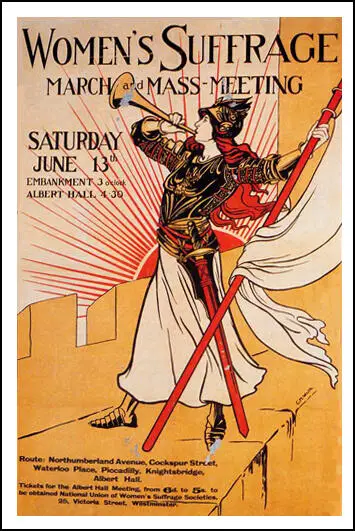
The image created by Watts appeared on NUWSS posters and pamphlets. It was also used on a badge given to NUWSS's paid organisers. A member of the NUWSS governing-council argued in The Common Cause: "Our Bugler Girl carries her bugle and her banner; her sword is sheathed by her side; it is there, but not drawn, and if it were drawn, it would not be the sword of the flesh, but of the spirit. For ours is not a warfare against men, but against evil." (20)
Banners for Processions
In an attempt to persuade Henry Campbell-Bannerman and his government to give women the vote the NUWSS decided to hold its largest demonstration in its history. The Artists Suffrage League was asked to produce posters and banners for the march. (21) Organised by Philippa Strachey the United Procession of Women took place on 9th February 1907. It was a completely peaceful demonstration where more than three thousand women marched from Hyde Park Corner to the Strand in support of women's suffrage. It acquired the name "Mud March" from the day's weather, when incessant heavy rain left the marchers drenched and mud-spattered. (22)
The Artists Suffrage League was responsible for the design and execution of seventy to eighty embroided banners, which was shared out between a large number of women beyond the membership of the League itself. In 1909 it brought out four posters, six postcards and two Christmas cards. That year 34 members of the League produced banners for the Pageant of Women's Trades and Professions for the International Suffrage Alliance in April, 1909. (23)
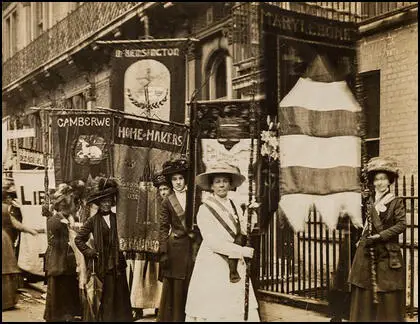
On 22nd October 1909 when the Women's Freedom League (WFL) established the Women's Tax Resistance League (WTRL). (24) Mary Sargant Florence was a founder member and was on its committee. (25) Florence designed a badge for the WTRL, showing a ship under sail and the slogan, "No Vote, No Tax". She also designed a poster depicting a Britannia figure, holding a a flowing "Reform" banner, and was used as a blank advertising poster, to be filled in with details of a society's meetings. The same design was also used for postcards. A painted banner was used in the 18th June 1910 WSPU procession. (26)
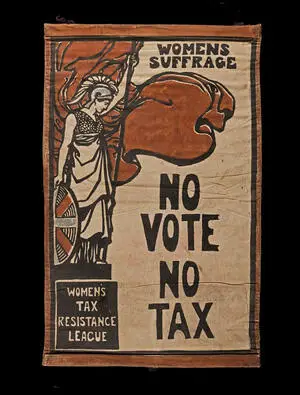
According to the The Suffrage Annual and Women's Whose Who (1913) "The Artists Suffrage League... published many illustrations, leaflets, and posters, which have been in continual demand in all parts of the country, and have played a part in General Elections and all by-elections since 1907. Another important branch of the work undertaken by the League has been the designing and producing of many beautiful banners for the various Branch Societies and Federations of the National Union. These banners have been carried in numbers of Suffrage processions, and have served on the occasion of important political meetings in favor of the Suffrage to decorate the great halls in London and in large provincial cities." (27)
Dora Meeson Coates
Dora Meeson Coates was a founder member of the Artists' Suffrage League (ASL). In 1908 Coates entered a NUSS poster competition. According to the Women's Franchise newspaper she took first place beating her friend Emily Harding Andrews into joint second place. The judges commented that they found it impossible to decide on which was the better, Miss Williams's design being the more artistic, while Mrs Andrews' would reproduce better". (28)
Dora's poster shows "Mrs John Bull" holding an empty dish labelled "Votes for Women" while six boys - Primrose League, Trade Unions, Liberal Federation, Women's Liberal Association, Social Democratic Federation and Independent Labour Party - clamour for more soup from a large bowl labelled "Political Help". The mother says: "Now you greedy boys I shall not give you any more until I have helped myself." (29)
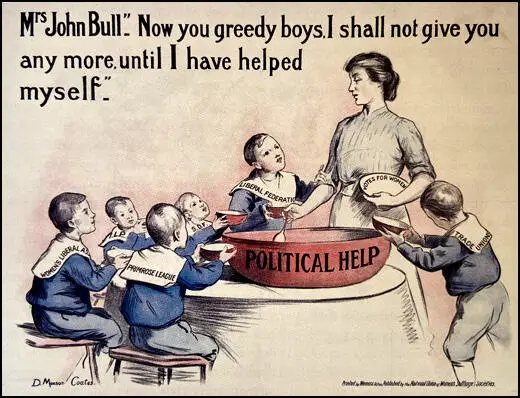
Dora also painted the 1908 London suffrage march union banner and designing posters and postcards to publicise similar marches. Dora worked with Cicely Hamilton and Mary Lowndes and contributed powerful line drawings to the Artists' Suffrage League publications Beware! A Warning to Suffragists (1909) and A.B.C. of Politics for Women Politicians (1910). (30) During this period she contributed articles and art work for The Common Cause and The Englishwoman. (31)
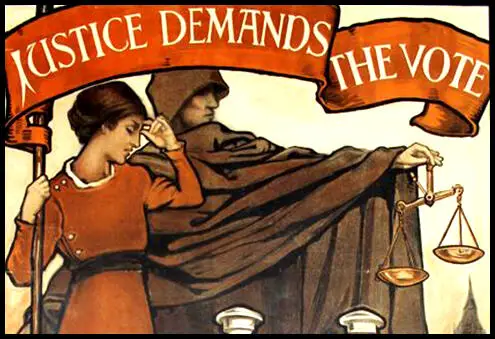
Members of the Artists' Suffrage League who contributed designs during this period included Mary Lowndes, Emily Harding Andrews, Susan Beatrice Pearse, Emily Ford, Caroline Watts, Dora Meeson Coates, Mary Sargant Florence, Bertha Newcombe, Charlotte Charlton, Joan Harvey Drew, Barbara Forbes, May Barker, Clara Billing, Ellen Woodward, Mary Wheelhouse, Christina Herringham and Harriet Adkins. (32)
Bertha Newcombe
As a member of the Artists' Suffrage League, Bertha Newcombe, produced art-work for the 1910 General Election. The National Union of Women's Suffrage Societies were angry with the Liberal Party government that had not kept its promise to give women the vote and decided to raise funds in order to support Labour Party, as the only political party which really supported women's suffrage. (33) Bertha Newcombe agreed to produce a poster for its Election Fighting Fund. (34)
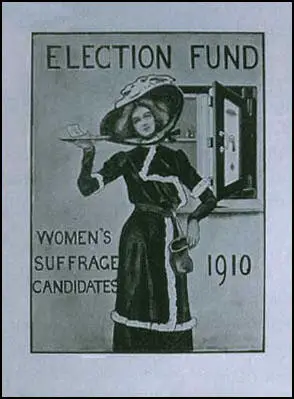
In 1910 Bertha Newcombe painted An Incident in Connection with the Presentation of the First Women's Suffrage Petition to Parliament in 1866. The picture showed Emily Davies and Elizabeth Garrett hiding first women’s suffrage petition under an apple-woman’s stall in Westminster Hall until John Stuart Mill came to collect it. As a non-militant, Bertha was keen to emphasize the constitutional methods of the suffrage movement "in clear contrast to the revolutionary and satirical suffrage images more commonly seen". (35)
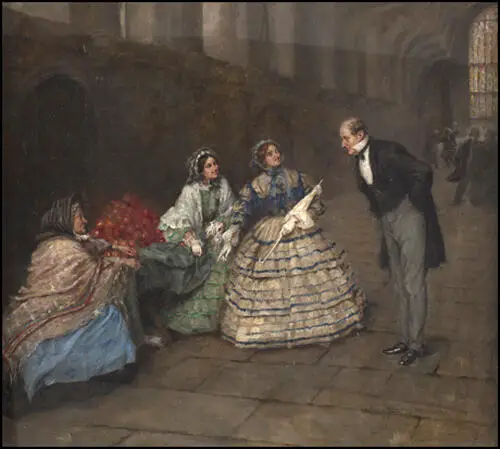
hiding first women’s suffrage petition under an apple-woman’s stall in Westminster Hall
until John Stuart Mill came to collect it. It was entitled An Incident in Connection with the Presentation of the First Women's Suffrage Petition to Parliament in 1866 (1910)
Primary Sources
(1) The Suffrage Annual and Women's Whose Who (1913)
The object of the League is to further the cause of Women's Enfranchisement by the work and professional help of artists. With this aim the League has published many illustrations, leaflets, and posters, which have been in continual demand in all parts of the country, and have played a part in General Elections and all by-elections since 1907. The posters of the Artists' League have also been constantly supplied to America for the use of the National Association, whose headquarters are in New York. They also played a part in the successful campaign in California.
Another important branch of the work undertaken by the League has been the designing and producing of many beautiful banners for the various Branch Societies and Federations of the National Union. These banners have been carried in numbers of Suffrage processions, and have served on the occasion of important political meetings in favor of the Suffrage to decorate the great halls in London and in large provincial cities.
Besides these banners, many other effective decorations have been devised by the Artists' Suffrage League for the various National Union demonstrations that have taken place. The decorative work for the Women's Trades' procession in 1909, when the International Congress took place in London, was perhaps the most unique of the various undertakings of the League. On this occasion a thousand women marched through London to the Albert Hall carrying emblems representing about 90 different trades, each trade being represented by a group of twelve bona fide workers, who had come from all parts of the country for the occasion. This procession, which crossed London at dusk, was illuminated by hundreds of coloured lanterns.
The Artists' League has in continual instances responded to demands from the National Union for special decorations, and has materially helped political demonstrations and done much to popularize the cause of Woman's Suffrage by bringing in an attractive manner before the public eye the long-continued demand for the vote.
(2) Philippa Strachey, letter to Millicent Garrett Fawcett (22nd June, 1908)
She (Mary Lowndes) got the banners made and worked out every detail in connection with them without letting us have the smallest trouble about them from first to last. On the Committee she was most helpful about everything and was delightful to work with because she was entirely free from any sort of nonsense; she only cared about the success of the procession as a whole and was perfectly willing to subordinate her decorations and give up all her cherished ideas when difficulties cropped up. She really did an immense amount of work for us and I shudder to think of what has happened to her own trade meantime.
(3) Mary Lowndes, On Banners and Banner-Making (1909)
A banner is not a placard... a banner is a thing to float in the wind, to flicker in the breeze, to flirt its colours for your pleasure, to half show and half conceal a device you long to unravel: you do not want to read it, you want to worship it.
(4) Elizabeth Crawford, Art and Suffrage: A Biographical Dictionary of Suffrage Artists (2018)
The actual album in which Mary Lowndes sketched out her designs for work associated with the ASL has survived and is now held in the Women's Library/LSE collection. The ASL's first major commission was to provide banners for the 13 June 1908 NUWSS procession and Mary Lowndes's album includes not only the designs but the colours to be used, indicated in watercolour, and, in many instances, with swatches of a likely fabric attached... The album also includes designs Mary Lowndes created for the Pageant of Women's Trades and Professions which, on 27 April 1909, processed from Eaton Square to the Albert Hall, with each trade and profession carrying its own symbol, marking the Quinquennial Congress of the International Woman Suffrage Alliance.
(5) The Common Cause (22nd December, 1910)
The Artists' Suffrage League has published in all ten of these posters and I can quite believe people are pretty tired of many of them, as, indeed, we are ourselves. I have been asked why we did not issue new ones for this last general election; it is this question that I want to answer. I need not dwell on the unexpectedness of the election when it finally burst on us, and the hurry with which the whole matter has been conducted. Such haste, however, affects nothing more than placards, as all observers may have noted for themselves. Apart from this our Society cannot well issue many posters till it disposes of the old ones. Coloured posters are expensive. To be able to sell them at fourpence each (without making any profit) we are obliged to have at least 1000 copies printed at the same time. Now, these copies sell off very slowly. When a society has ordered six of each sort it feels it has sent a large order, and that particular society probably wants no more for six months. But six copies of one design makes a very small inroad into a thousand. It takes us from one to two years to sell 1000 copies. We have laid out on this design ten to fifteen pounds, say, and this sum comes back in driblets. cannot print new posters till our money returns, or till we have amassed large profits on selling postcards, or other objects.
If people would purchase posters in hundreds and really post them on the hoardings we should soon get through our 10,000 copies, and I think then we should not be remiss about producing new designs. One or two generous people sent the Artists' League money for posting 200+ posters in East St Pancras. I think myself this money was well bestowed - people look a great deal at the pictures on the hoardings. For the information of anyone who may meditate a like extravagance, I may say that a quad-crown poster (price fourpence) costs in a general way fourpence to post. It is known to your readers that the Artists' League issued one new poster for their election, "Votes for Mothers". It was rather an expensive one to produce, and we were obliged to have 2000 copies at once to enable us to sell it at fourpence. We hope very much it will be bought up quickly.
(6) Elizabeth Crawford, Art and Suffrage: A Biographical Dictionary of Suffrage Artists (2018)
Between 1896 and 1898 Dora studied in London, at the Slade School. In 1903 she married an Australian artist, George Coates, and they lived in Chelsea in the studio whose previous tenant had been Augustus John, with whom Dora had been a fellow pupil at the Slade. Dora described the Trafalgar Studios as "a nest of busy workers" and it was here that by chance she met Mary Sargant Florence on an evening when the latter was looking for a suffrage meeting being held in a neighbouring studio. This was probably the one belonging to Florence Haig, an artist and militant member of the Women's Social and Political Union, who became one of Dora's close friends... It was in Florence's studio, at a suffrage meeting at which Mrs Pankhurst was the principal speaker that Dora first met Cicely Hamilton, with whom she would later work on two ASL publications.
As Dora wrote: "George and I threw ourselves heart and soul into the suffrage movement and in 1907 she was a founder member of the Artist's Suffrage League. Working with Mary Lowndes in the ASL she met Christiana Herringham, the founder of the Tempera Society, Annie Swynnerton, and Emily Ford, with whom for a time she shared a studio. She wrote that she avoided doing anything really militant because her husband would have upset if she had gone to prison.

